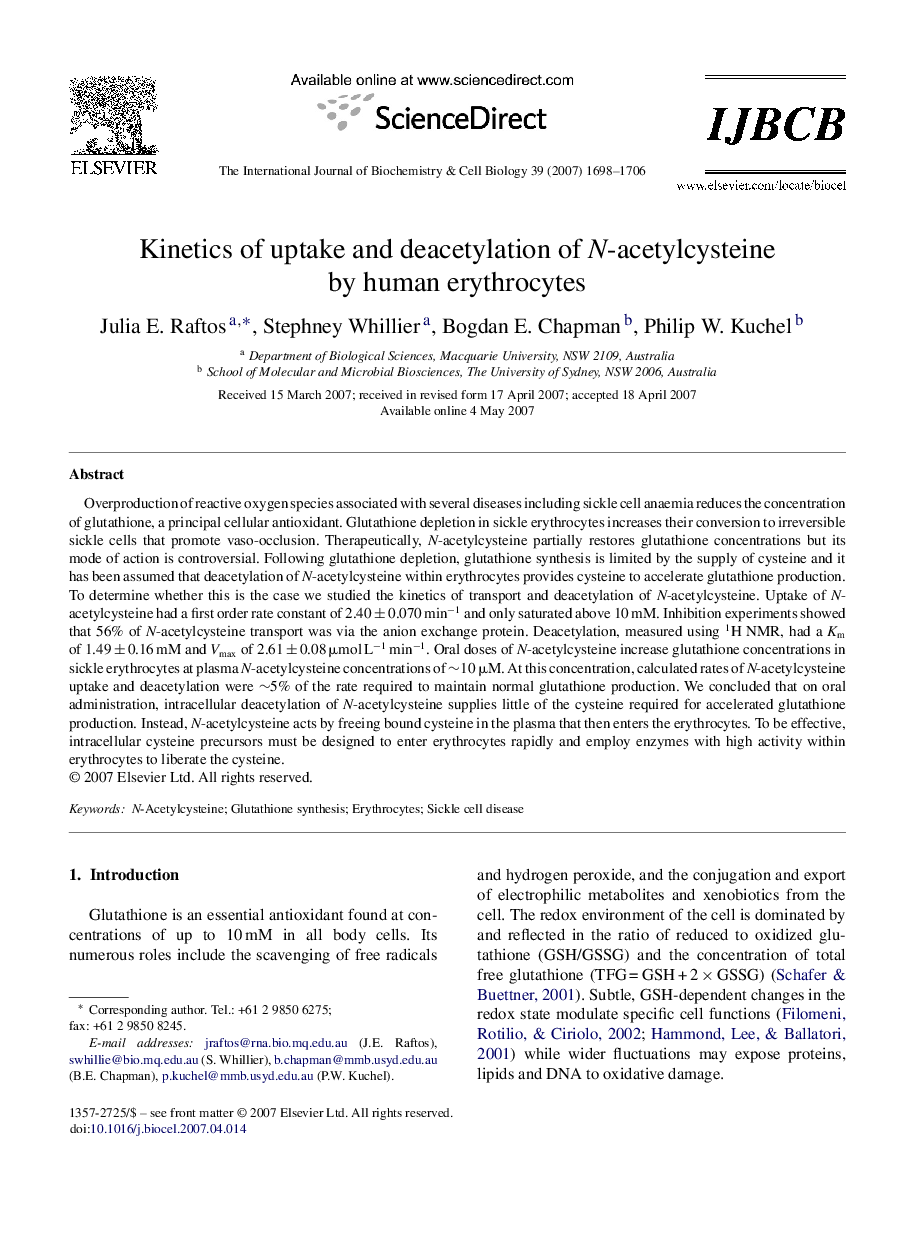| کد مقاله | کد نشریه | سال انتشار | مقاله انگلیسی | نسخه تمام متن |
|---|---|---|---|---|
| 8326367 | 1539972 | 2007 | 9 صفحه PDF | دانلود رایگان |
عنوان انگلیسی مقاله ISI
Kinetics of uptake and deacetylation of N-acetylcysteine by human erythrocytes
دانلود مقاله + سفارش ترجمه
دانلود مقاله ISI انگلیسی
رایگان برای ایرانیان
کلمات کلیدی
موضوعات مرتبط
علوم زیستی و بیوفناوری
بیوشیمی، ژنتیک و زیست شناسی مولکولی
زیست شیمی
پیش نمایش صفحه اول مقاله

چکیده انگلیسی
Overproduction of reactive oxygen species associated with several diseases including sickle cell anaemia reduces the concentration of glutathione, a principal cellular antioxidant. Glutathione depletion in sickle erythrocytes increases their conversion to irreversible sickle cells that promote vaso-occlusion. Therapeutically, N-acetylcysteine partially restores glutathione concentrations but its mode of action is controversial. Following glutathione depletion, glutathione synthesis is limited by the supply of cysteine and it has been assumed that deacetylation of N-acetylcysteine within erythrocytes provides cysteine to accelerate glutathione production. To determine whether this is the case we studied the kinetics of transport and deacetylation of N-acetylcysteine. Uptake of N-acetylcysteine had a first order rate constant of 2.40 ± 0.070 minâ1 and only saturated above 10 mM. Inhibition experiments showed that 56% of N-acetylcysteine transport was via the anion exchange protein. Deacetylation, measured using 1H NMR, had a Km of 1.49 ± 0.16 mM and Vmax of 2.61 ± 0.08 μmol Lâ1 minâ1. Oral doses of N-acetylcysteine increase glutathione concentrations in sickle erythrocytes at plasma N-acetylcysteine concentrations of â¼10 μM. At this concentration, calculated rates of N-acetylcysteine uptake and deacetylation were â¼5% of the rate required to maintain normal glutathione production. We concluded that on oral administration, intracellular deacetylation of N-acetylcysteine supplies little of the cysteine required for accelerated glutathione production. Instead, N-acetylcysteine acts by freeing bound cysteine in the plasma that then enters the erythrocytes. To be effective, intracellular cysteine precursors must be designed to enter erythrocytes rapidly and employ enzymes with high activity within erythrocytes to liberate the cysteine.
ناشر
Database: Elsevier - ScienceDirect (ساینس دایرکت)
Journal: The International Journal of Biochemistry & Cell Biology - Volume 39, Issue 9, 2007, Pages 1698-1706
Journal: The International Journal of Biochemistry & Cell Biology - Volume 39, Issue 9, 2007, Pages 1698-1706
نویسندگان
Julia E. Raftos, Stephney Whillier, Bogdan E. Chapman, Philip W. Kuchel,